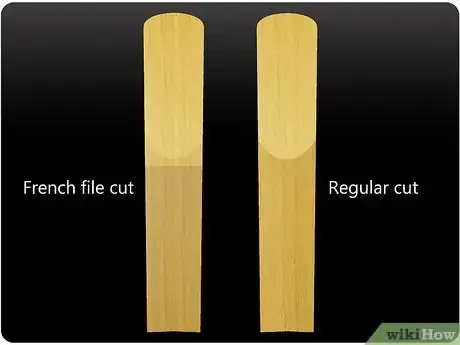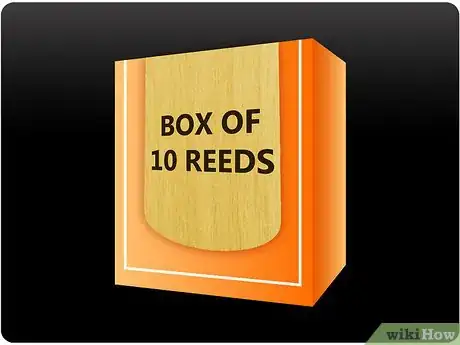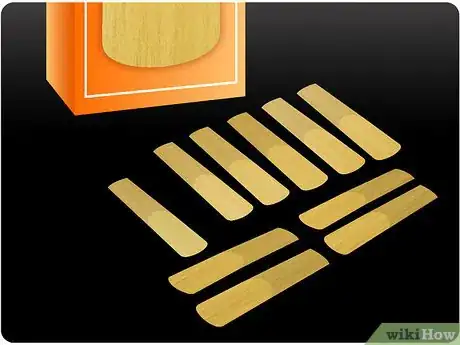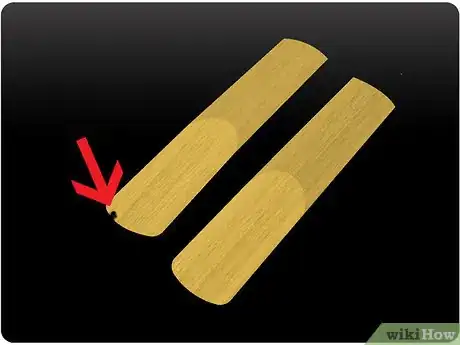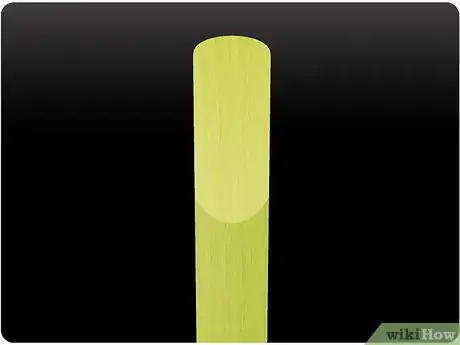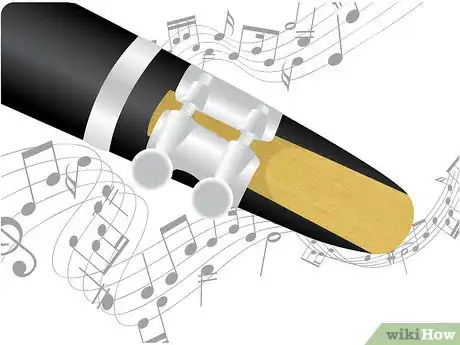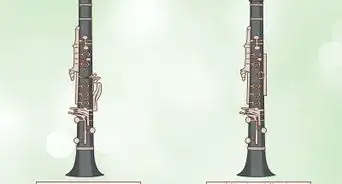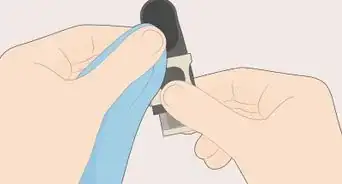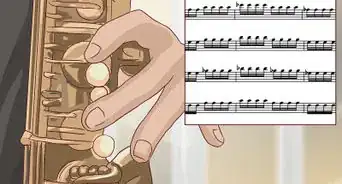wikiHow is a “wiki,” similar to Wikipedia, which means that many of our articles are co-written by multiple authors. To create this article, 24 people, some anonymous, worked to edit and improve it over time.
wikiHow marks an article as reader-approved once it receives enough positive feedback. This article received 15 testimonials and 92% of readers who voted found it helpful, earning it our reader-approved status.
This article has been viewed 249,001 times.
Learn more...
While every part of the clarinet has its own purpose in producing a good sound, perhaps the most important piece is the two-and-a-half inch long, wafer-thin piece of cane called the reed. Reeds come in different strengths and cuts, and can be good or bad. A good reed is vitally important for a good sound and tone, so it's important to be able to identify one.
Steps
-
1Choose a brand. There are many to choose from, and all brands make and sell their reeds a little differently. Rico, a US brand, is popular with all clarinetists, and is often recommended for beginners. It also makes reeds under the La Voz and Mitchell Lurie names. Vandoren (which also makes mouthpieces) is a popular French brand. Other French brands, some lesser known than others, include Selmer (which also makes clarinets), Rigotti, Marca, Glotin, and Brancher. Some other (and more uncommon) brand names are Alexander Superial (Japan), Reeds Australia, Peter Ponzol (also makes mouthpieces), RKM, and Zonda. If you're still relatively new to playing, Rico and Vandoren are both highly recommended brands.[1]
-
2Decide what strength you'll need. Most reed manufacturers sell reeds in strengths from 1 to 5, often in half-steps. A 1 would be the softest, and a 5 would be the hardest. Some brands use "soft", "medium", and "hard" instead. For a beginner, a 2, or 2 /12 would be the best starting point. Keep in mind, however, that what one brand calls a 2 1/2 may be another brand's 2 or 3. Also, a box of 2 1/2s will have some variants... some that are closer to a hard 2, or a soft 3.[2]
- A harder reed gives a heavier, thicker, and fuller sound. It's more difficult to correct the pitch with a harder reed, but it also means that changing dynamics won't result in pitch variations as easily. It's also more difficult to play low pitches softly with a hard reed, but altissimo notes are easier to reach.
- A softer reed makes playing easier - the reed speaks more easily, and gives a lighter, brighter sound. However, there is a greater chance for pitch variations as you play, though it is easier to correct the pitch with your embouchure. High notes can be difficult to achieve with a soft reed. Also, fast tonguing (16th notes at 90 or more BPM) can be harder on softer reeds.
Advertisement -
3Decide on a cut. Reeds come in either "regular" or "French file" cuts. Cut won't matter to a beginning student, but file-cut reeds generally have a faster response time, and the few extra bucks to buy them are definitely worth it. You can identify a regular-cut reed as having the cane on the bottom meet the sanded part in a clean U-shape. On a file-cut reed, part of the "U" has been shaved down a bit to create a flat edge on the thick cane (see image). Players with darker-sounding mouthpieces may prefer filed reeds, while ones with brighter-sounding ones will stick with regular-cut ones.[3]
-
4Go to the music store and buy a box of reeds. It's okay to buy one or two, but the more reeds you have, the more good ones you have, and buying in bulk will save you a lot of trips to the music store. A box of ten should last you a few weeks, though you can choose to buy more.
-
5Take all the reeds out of the box, and get ready to evaluate them.[4]
- Check for splits and cracks. Throw away any broken reeds - they're beyond hope already.
- Hold them up to the light, one at a time. You should see an inverted "V" shape. A good reed has a perfectly centered and symmetrical "V". A "crooked" V will be hard to play, and there is a risk of squeaks.
- However, if the "V" is only slightly off-centered, you can remedy the problem by shifting the reed slightly so that the "V" is centered on the mouthpiece (not centered on the reed)
- An uneven grain (where the little vertical lines in the reed are pointing towards the V instead of running straight through it) will not play well, either.
- A reed with knots (little spots or dark areas in the grain) will vibrate unevenly, and is also a dud.
- Take a look at the color. A good reed is yellow to golden-brown. A green reed is too young, and will not play well, if it plays at all. Take green reeds and leave them somewhere for a few months - sometimes they improve themselves over time.
-
6Play-test the good reeds. The duds can be thrown away or left to sit for a few months, depending on what was wrong, and you should be left with a handful of good ones. Test them to make sure they play well, and always have at least 3 good reeds on hand. You can purchase a special reed holder for this.[5]
Community Q&A
-
QuestionIs it okay to use the flavored reeds from the brand Flavoreeds on my clarinet, or will it damage my instrument?
 Nicholas R.Community AnswerIt is unlikely any reed will damage your instrument; however; any reeds made for such a purpose are never really as good as standard reeds.
Nicholas R.Community AnswerIt is unlikely any reed will damage your instrument; however; any reeds made for such a purpose are never really as good as standard reeds. -
QuestionCan I use a bass clarinet reed on a Bb clarinet, and is there a major difference?
 Community AnswerNo, Bb clarinet reeds are smaller, and the bass clarinet reed will not fit the mouthpiece of the Bb.
Community AnswerNo, Bb clarinet reeds are smaller, and the bass clarinet reed will not fit the mouthpiece of the Bb. -
QuestionDoes Vandoren create 4.5 reeds?
 Community AnswerVandoren does create 4.5 reeds. You can buy them online or at a music store. Vandoren has 4.5 reeds for bb clarinets and eb clarinets.
Community AnswerVandoren does create 4.5 reeds. You can buy them online or at a music store. Vandoren has 4.5 reeds for bb clarinets and eb clarinets.
Warnings
- Don't CONSTANTLY upgrade your reed size OR start with anything greater than a 2 1/2 (i recommend starting on 2's however). This is a mistake MANY beginners make. I recommend starting with size 2 of the Rico orange box to start with.The misconception is, the harder reed you use, the better you are. INCORRECT. It has to do with, the style of music (a jazz player NEVER uses reeds really harder than about a 3), the tip opening of the mouthpiece (ex. a 7 tip opening should be about size 2 /12 to 3 reeds 'for a PRO'), the reeds thickness (ex. Rico Reserve vs Rico Royal), and the brand of reed your using (Some are WAY softer than what the range is).⧼thumbs_response⧽
- Don't complain about a "bad" box of reeds. The reeds have been through a lot of shipping to get to you, and the cane varies. You'll get a box of all duds every once in a while... just go with it, and buy another box, if necessary. ALL brands normally have AT LEAST one or two bad reeds a box (for a consistent brand) while some brands have about 7/10 or 8/10 of the reeds are bad. If you are experienced enough, in many cases bad reeds can be adjusted to play far better than their original states.⧼thumbs_response⧽
- When adjusting reeds, be very careful, as it's easy to remove too much. Taking as little as 1/100 mm from the tip of a reed makes it 10% thinner, and you can't "repair" a reed once you've messed it up.⧼thumbs_response⧽
References
- ↑ https://www.soundunlimited.co.uk/blogs/articles/saxophone-and-clarinet-reeds-beginner-guide
- ↑ https://www.youtube.com/watch?v=jCZPbfxA-sc
- ↑ http://thevault.musicarts.com/how-to-choose-a-clarinet-reed/
- ↑ https://www.hopestreetmusicstudios.com/articles/adjusting-saxophone-and-clarinet-reeds
- ↑ https://www.hopestreetmusicstudios.com/articles/adjusting-saxophone-and-clarinet-reeds


